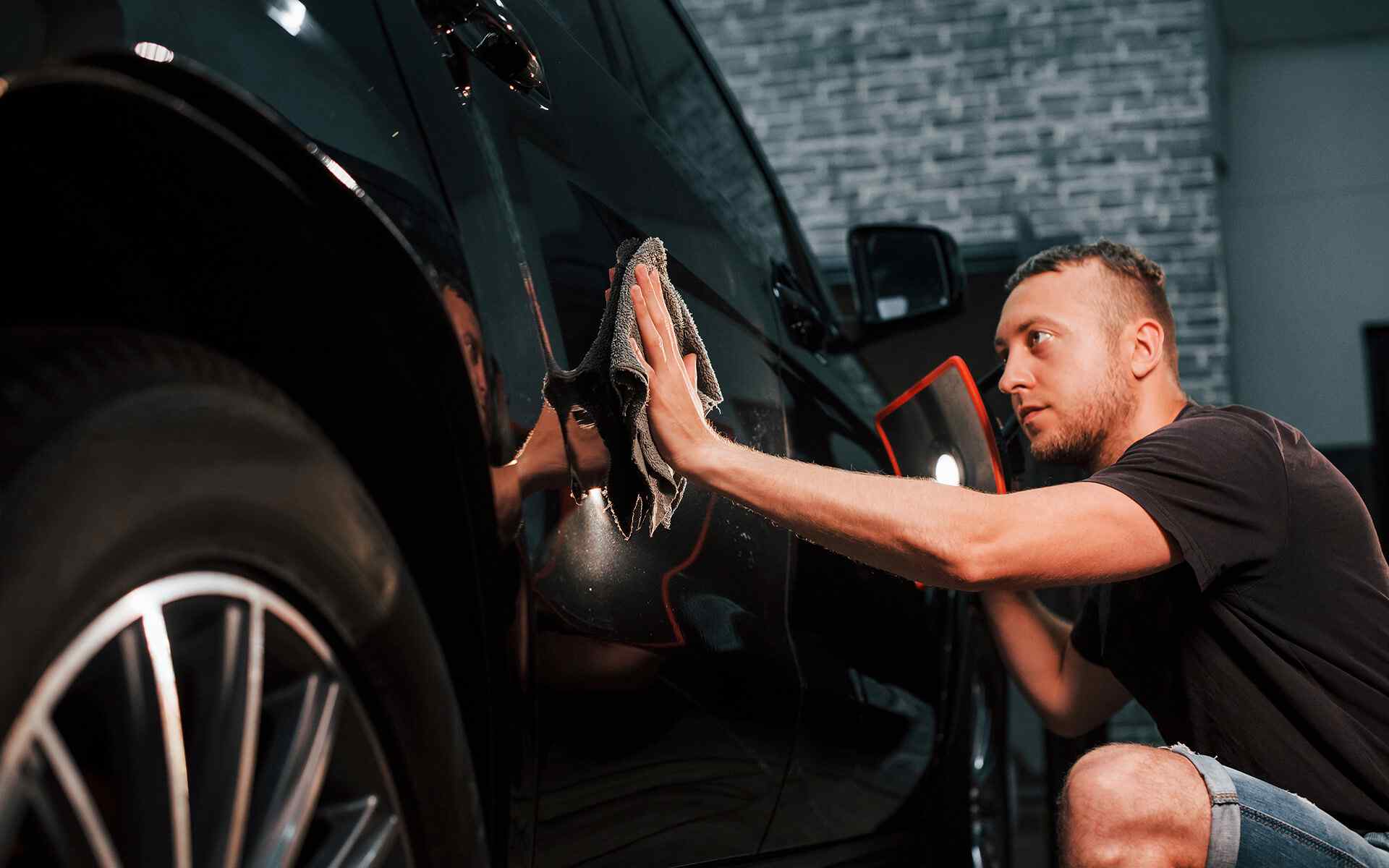Ceramic coating has become increasingly popular in the automotive industry as a way to protect and enhance the appearance of vehicles. This innovative technology provides a long-lasting, high-gloss finish that helps to protect the paint from UV rays, scratches, and chemical stains. In addition to its protective properties, ceramic coating also provides a sleek and glossy finish that enhances the overall appearance of the vehicle. In this article, we will explore what ceramic coating is, how it works, its benefits for your vehicle, different types of ceramic coating, how to prepare your vehicle for ceramic coating, the application process, curing and maintenance, how long it lasts, common misconceptions, professional vs. DIY options, frequently asked questions, and a conclusion.
Key Takeaways
- Ceramic coating is a liquid polymer that is applied to the exterior of a vehicle to protect it from environmental damage.
- Benefits of ceramic coating include protection from UV rays, scratches, and chemical stains, as well as a glossy finish and easier cleaning.
- There are different types of ceramic coating, including professional-grade and DIY options, and it's important to choose the right one for your needs.
- Preparing your vehicle for ceramic coating involves thorough cleaning and decontamination to ensure the coating adheres properly.
- The application process of ceramic coating involves careful and precise application, followed by a curing period and ongoing maintenance to ensure longevity.
What is Ceramic Coating and How Does it Work?
Ceramic coating is a liquid polymer that is applied to the exterior of a vehicle to protect its paint from various environmental contaminants. It forms a strong bond with the paint surface and creates a protective layer that is resistant to UV rays, scratches, and chemical stains. The coating is made up of nanoparticles that fill in the microscopic pores of the paint surface, creating a smooth and hydrophobic barrier.When applied correctly, ceramic coating can provide long-lasting protection for your vehicle's paint. It works by creating a protective layer that is resistant to UV rays, which can cause fading and oxidation of the paint over time. It also helps to prevent scratches and swirl marks by providing a sacrificial layer that absorbs the impact of minor abrasions. Additionally, ceramic coating creates a hydrophobic surface that repels water and other liquids, making it easier to clean and maintain the vehicle's appearance.
Benefits of Ceramic Coating for Your Vehicle
There are several benefits to applying ceramic coating to your vehicle. One of the main advantages is its ability to protect against UV rays, which can cause fading and oxidation of the paint. By creating a barrier between the paint and the sun's harmful rays, ceramic coating helps to maintain the color and shine of your vehicle's paint for a longer period of time.Another benefit of ceramic coating is its ability to protect against scratches and swirl marks. The coating forms a sacrificial layer that absorbs the impact of minor abrasions, preventing them from reaching the paint surface. This helps to keep your vehicle looking newer for longer and reduces the need for frequent paint correction.In addition to its protective properties, ceramic coating also enhances the gloss and shine of your vehicle's paint. The coating creates a smooth and reflective surface that gives your vehicle a showroom-like finish. This not only improves the overall appearance of your vehicle but also makes it easier to clean and maintain.
Different Types of Ceramic Coating and Which One to Choose
| Type of Ceramic Coating | Features | Benefits | Recommended for |
|---|
| SiO2 Ceramic Coating | Highly durable, hydrophobic, UV resistant | Long-lasting protection, easy to clean, enhances gloss | Cars, boats, motorcycles |
| TiO2 Ceramic Coating | Self-cleaning, anti-static, scratch-resistant | Repels dirt and grime, reduces maintenance, protects against minor scratches | Outdoor surfaces, such as building facades, solar panels |
| Quartz Ceramic Coating | Chemical resistant, high gloss, heat resistant | Protects against harsh chemicals, enhances shine, withstands high temperatures | Kitchen countertops, industrial equipment, exhaust systems |
| Nano Ceramic Coating | Ultra-thin, flexible, breathable | Does not alter surface appearance, allows for natural breathability, protects against environmental damage | Historic buildings, monuments, delicate surfaces |
There are several different types of ceramic coating available on the market, each with its own unique properties and benefits. It is important to choose the right type of ceramic coating for your vehicle based on factors such as the climate you live in, your driving habits, and your budget.One popular type of ceramic coating is a silica-based coating. This type of coating is known for its durability and resistance to UV rays, scratches, and chemical stains. It provides long-lasting protection for your vehicle's paint and is relatively easy to apply.Another type of ceramic coating is a polymer-based coating. This type of coating is known for its high-gloss finish and hydrophobic properties. It creates a smooth and reflective surface that enhances the appearance of your vehicle's paint and makes it easier to clean.When choosing the right type of ceramic coating for your vehicle, it is important to consider factors such as the climate you live in. If you live in an area with harsh winters or extreme heat, you may want to choose a ceramic coating that offers enhanced protection against these conditions. Additionally, consider your driving habits and the level of maintenance you are willing to commit to. Some ceramic coatings require regular maintenance to maintain their effectiveness, while others are more low-maintenance.
How to Prepare Your Vehicle for Ceramic Coating
Before applying ceramic coating to your vehicle, it is important to properly prepare the surface to ensure optimal adhesion and longevity of the coating. This involves several steps, including thorough cleaning and decontamination.The first step in preparing your vehicle for ceramic coating is to wash it thoroughly. Use a high-quality car wash soap and a microfiber wash mitt to remove any dirt, grime, and debris from the surface. Pay special attention to areas such as the wheels, wheel wells, and lower portions of the vehicle where dirt and road grime tend to accumulate.After washing the vehicle, it is important to decontaminate the paint surface. This involves removing any embedded contaminants such as tar, tree sap, or industrial fallout that cannot be removed through regular washing. There are several products available on the market specifically designed for this purpose, such as clay bars or iron fallout removers. Follow the instructions on the product packaging to safely and effectively remove these contaminants from the paint surface.Once the paint surface is clean and free of contaminants, it is important to polish it to remove any imperfections such as swirl marks or light scratches. This will help to create a smooth and uniform surface for the ceramic coating to adhere to. Use a dual-action polisher and a polishing compound to gently buff the paint surface until it is smooth and glossy.Finally, it is important to wipe down the paint surface with a paint prep solution or isopropyl alcohol to remove any remaining residue or oils. This will ensure that the ceramic coating can bond properly with the paint surface.
The Application Process of Ceramic Coating
Applying ceramic coating to your vehicle can be a time-consuming process, but when done correctly, it can provide long-lasting protection and a high-gloss finish. Here is a step-by-step guide to applying ceramic coating:1. Start by ensuring that the vehicle is clean and dry. Make sure to remove any dirt, grime, or contaminants from the paint surface.2. Apply a small amount of ceramic coating to an applicator pad or microfiber cloth. It is important to use a high-quality applicator pad or cloth to ensure even application of the coating.3. Working in small sections, apply the ceramic coating to the paint surface using gentle, overlapping motions. Make sure to apply a thin and even layer of the coating, avoiding any excess buildup.4. Allow the ceramic coating to cure for the recommended amount of time. This can vary depending on the specific product you are using, so make sure to read and follow the instructions provided by the manufacturer.5. Once the coating has cured, use a clean microfiber cloth to buff off any excess residue or streaks. This will help to create a smooth and glossy finish.6. Repeat the process for each section of the vehicle until the entire surface has been coated.
Curing and Maintenance of Ceramic Coating
After applying ceramic coating to your vehicle, it is important to allow it to cure properly before exposing it to water or other elements. The curing process can take anywhere from 24 hours to several days, depending on the specific product you are using and the environmental conditions.During the curing process, it is important to keep your vehicle dry and avoid washing it or exposing it to rain or other sources of moisture. This will allow the ceramic coating to bond properly with the paint surface and provide optimal protection.Once the ceramic coating has cured, it is important to maintain it properly to ensure its longevity and effectiveness. This involves regular washing and maintenance to remove dirt, grime, and other contaminants from the surface.When washing your vehicle, use a high-quality car wash soap and a microfiber wash mitt to gently remove dirt and grime. Avoid using abrasive brushes or sponges, as they can cause scratches or swirl marks on the paint surface.In addition to regular washing, it is also important to periodically apply a ceramic coating booster or maintenance spray to refresh the protective properties of the coating. These products help to rejuvenate the hydrophobic properties of the coating and enhance its ability to repel water and other liquids.
How Long Does Ceramic Coating Last?
The lifespan of ceramic coating can vary depending on several factors, including the quality of the product, the application process, and the level of maintenance. On average, ceramic coating can last anywhere from 1 to 5 years, with some high-quality coatings lasting up to 10 years.To ensure the longevity of your ceramic coating, it is important to follow the manufacturer's instructions for application and maintenance. This includes properly preparing the surface before applying the coating, allowing it to cure properly, and regularly washing and maintaining the coating.It is also important to note that certain factors can affect the lifespan of ceramic coating. For example, exposure to harsh environmental conditions such as extreme heat or cold can cause the coating to degrade more quickly. Additionally, frequent exposure to abrasive materials such as road salt or gravel can also reduce the lifespan of the coating.
Common Misconceptions about Ceramic Coating
There are several common misconceptions about ceramic coating that can lead to confusion or misunderstanding. Here are some of the most common myths debunked:Myth 1: Ceramic coating is scratch-proof.
While ceramic coating does provide a sacrificial layer that helps to protect against minor scratches and swirl marks, it is not completely scratch-proof. It is still possible for deeper scratches or abrasions to penetrate the coating and reach the paint surface.Myth 2: Ceramic coating eliminates the need for regular washing.
While ceramic coating does make it easier to clean and maintain your vehicle, it does not eliminate the need for regular washing. Regular washing is still necessary to remove dirt, grime, and other contaminants from the surface.Myth 3: Ceramic coating is a one-time application.
While ceramic coating can provide long-lasting protection, it is not a one-time application. Over time, the coating will begin to degrade and lose its effectiveness. Periodic maintenance and reapplication may be necessary to maintain the protective properties of the coating.
Professional vs. DIY Ceramic Coating: Which One is Better?
When it comes to applying ceramic coating to your vehicle, you have the option of hiring a professional or doing it yourself. Both options have their pros and cons, and the right choice depends on factors such as your budget, time constraints, and level of expertise.Hiring a professional to apply ceramic coating to your vehicle can ensure that the job is done correctly and efficiently. Professionals have the knowledge, experience, and equipment necessary to properly prepare the surface, apply the coating evenly, and achieve optimal results. Additionally, hiring a professional can save you time and effort, as they will take care of all the necessary steps involved in the application process.On the other hand, applying ceramic coating yourself can be a cost-effective option if you are willing to put in the time and effort. There are several DIY ceramic coating kits available on the market that provide all the necessary materials and instructions for application. While it may take longer to achieve professional-level results, with proper preparation and attention to detail, you can still achieve a high-quality finish.When making the decision between professional vs. DIY ceramic coating, consider factors such as your budget, time constraints, and level of expertise. If you have the budget and prefer a hassle-free experience, hiring a professional may be the best option for you. However, if you enjoy working on your vehicle and have the time and patience to dedicate to the application process, DIY ceramic coating can be a rewarding and cost-effective option.
Frequently Asked Questions about Ceramic Coating
Q: Is ceramic coating worth the investment?
A: Ceramic coating can be a worthwhile investment for those looking to protect and enhance the appearance of their vehicle. It provides long-lasting protection against UV rays, scratches, and chemical stains, and enhances the gloss and shine of the paint.Q: Can ceramic coating be applied to any vehicle?
A: Ceramic coating can be applied to most vehicles, including cars, trucks, motorcycles, and boats. However, it is important to consider factors such as the condition of the paint and the level of maintenance required before applying ceramic coating.Q: Can I apply ceramic coating myself?
A: Yes, it is possible to apply ceramic coating yourself using a DIY kit. However, it is important to follow the instructions provided by the manufacturer and take the necessary steps to properly prepare the surface before application.Q: How long does it take to apply ceramic coating?
A: The application process for ceramic coating can vary depending on factors such as the size of the vehicle and the level of preparation required. On average, it can take anywhere from a few hours to a full day to apply ceramic coating.Q: Can I wax my vehicle after applying ceramic coating?
A: It is generally not necessary to wax your vehicle after applying ceramic coating, as the coating provides a high-gloss finish. However, if you prefer to wax your vehicle for added protection or shine, make sure to use a wax that is compatible with ceramic coatings.Ceramic coating is an innovative technology that provides long-lasting protection and a high-gloss finish for your vehicle's paint. It helps to protect against UV rays, scratches, and chemical stains, while enhancing the overall appearance of your vehicle. With proper preparation and maintenance, ceramic coating can provide years of protection and a showroom-like finish.Whether you choose to hire a professional or apply ceramic coating yourself, it is important to consider factors such as your budget, time constraints, and level of expertise. Both options have their pros and cons, and the right choice depends on your individual needs and preferences.In conclusion, ceramic coating is a worthwhile investment for those looking to protect and enhance the appearance of their vehicle. It provides long-lasting protection against environmental contaminants and enhances the gloss and shine of the paint. Consider giving ceramic coating a try for yourself and experience the benefits it can provide for your vehicle.If you're interested in ceramic coating for your vehicle, you may also want to check out this article on Fleet Details about car detailing a Dodge Durango R/T. The article provides valuable insights into the benefits of ceramic coating and how it can protect your vehicle's paint from scratches, UV rays, and other environmental factors. To learn more about this topic, click
here.





